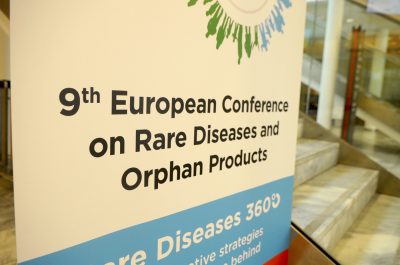#ECRD2018 – Genome Editing Might Be ‘Cure’ for Rare Diseases But Ethical Guidelines Needed, Panel Says

Entrance to the 9th European Conference on Rare Diseases and Orphan Products in Vienna. (Photo by Larry Luxner)
Should scientists have the right to edit the genes of future generations to eliminate hundreds, if not thousands, of potential rare diseases? Or should researchers restrict their use of genome editing to somatic cells, so that they don’t pass changes on to the next generation?
What about stem-cell research, three-parent in vitro fertilization (IVF), and experimenting on animals?
These and other ethical issues are at the center of society’s current debate on genome editing and its implications for patients with rare diseases — most of which have no treatments or cures.
“Somatic genome editing is being used in basic research, using human cells and modifying them for loads of different reasons,” said Heidi Howard, a senior researcher at Sweden’s Uppsala University. “There’s also somatic genome editing in clinical trials, and also for compassionate use. But for now, there are no regular standards of care used in genome editing.”
Howard was one of three experts speaking at a panel — “Genome Editing Debate: Are We Heading Towards a World Without Rare Diseases?” — that took place at the 9th European Conference on Rare Diseases & Orphan Products in Vienna on May 12.
The other two were Simon Woods, deputy director of policy, ethics and life sciences at England’s Newcastle University, and Nick Meade, director of policy at Genetic Alliance UK. The panel was moderated by Vivienne Parry, head of engagement at Genomics England.
“When the Human Genome Project came along, everybody was expecting there would be hundreds of thousands of genes,” Parry said. “But it turned out that we’ve only got about 20,000 genes, which, by the way, is the same as a starfish. And onions have 12 times more DNA than we have. More than that, genes contain only 2 to 3 percent of all the DNA in your genome.”
Yet Howard — a molecular geneticist who’s been studying ethical issues for the last 10 years — said there’s a distinction between somatic therapies, which target genes in specific types of cells (such as lung cells, skin cells and blood cells), and germline modifications, which when applied to sperm, eggs, or embryos alter the genes of offspring as well.
“Hereditary or germline editing is not being used in the clinical context at the moment,” Howard said. “In Europe, clinical trial regulations forbid us from doing germline modifications in clinical trials, though there is basic research happening in the U.K., Sweden, the U.S., China and likely other countries. There’s a regulatory framework around this that doesn’t allow germline gene editing to happen everywhere in research. It could also be related to a country’s laws on the use of embryos or stem cells.”
Ongoing clinical trials in genome editing — again, all at the somatic level and many addressing disease-causing mutations — involve respiratory disorders such as cystic fibrosis, severe skin diseases such as epidermolysis bullosa, and muscle-wasting diseases like muscular dystrophy and spinal muscular atrophy, but also T-cell immunotherapy, HIV, and hepatitis B.
A major breakthrough took place in 2015, when a year-old baby girl with aggressive leukemia, Layla Richards, became the first in the world to receive “designer immune cells” that had been genetically engineered to destroy her cancer. Waseem Qasim, a consultant immunologist at London’s Great Ormond Street Hospital — which gave Layla the 1 ml liquid infusion of immune cells — told The Guardian at the time: “This is a landmark in the use of new gene engineering technology and the effects for this child have been staggering.” According to a March 2018 report, she is still in remission.
As promising as the science behind genome editing seems, research is “still at a very experimental stage and there are all sorts of consequences of rolling out this technology,” said Woods, a philosopher who’s been involved in rare disease projects for several years.
“This is a moral and political question,” he said. “Who’s going to get these treatments? The science is simple, accurate and cheap, but that’s disingenuous. It’s only going to be cheap with the right kind of access. It’s going to be a niche market, like treatments for Duchenne.”
Woods added that one of the fundamental rights in medical research is the right to withdraw from a clinical trial. However, genome editing rewrites the rules of the game.
“It’s not like stopping a drug. You have, in effect, permanently changed something, so therefore there’s no real right to withdraw,” Woods said. “We must consider these issues. It actually changes the nature of medical research.”
Genetic Alliance UK’s Meade said using the correct definitions for scientific terms is crucial for a better understanding of the many ethical dilemmas involved.
“Genome editing is an incredibly broad topic, and a broad public discussion on genome editing will help us to realize its potential. The public must have a say in the limits of its use,” he said, identifying so-called three-parent IVF as an example of an ethically controversial treatment.
For this reason, Meade — whose London-based charity that represents more than 200 patient organizations across the U.K. — recommends using the term “genome editing” exclusively.
“Do not use potentially confusing alternatives such as gene editing, genetic editing, genomic editing, genome engineering, or genetic modification,” he said. “Deprioritize the term CRISPR. And when discussing the uses of genome editing, distinguish clearly between human and other uses, current and future uses, research and treatment, and uses that are currently permitted, and uses which would require regulatory change.”









